As decided in the most recent poll, and announced on Monday, today we come to the theme “dark tourism and clothing”:
You could be forgiven if you think this is a really exotic theme within the wider subject of dark tourism. But items of clothing do actually come up quite often. And the ones featured below are only a selection.
Perhaps the most predictable case of clothes with a dark association is those iconic and infamous striped concentration-camp-inmate outfits, such as this specimen on display at Natzweiler-Struthof (the red triangle with an “F” marked a French political prisoner, most likely a communist):
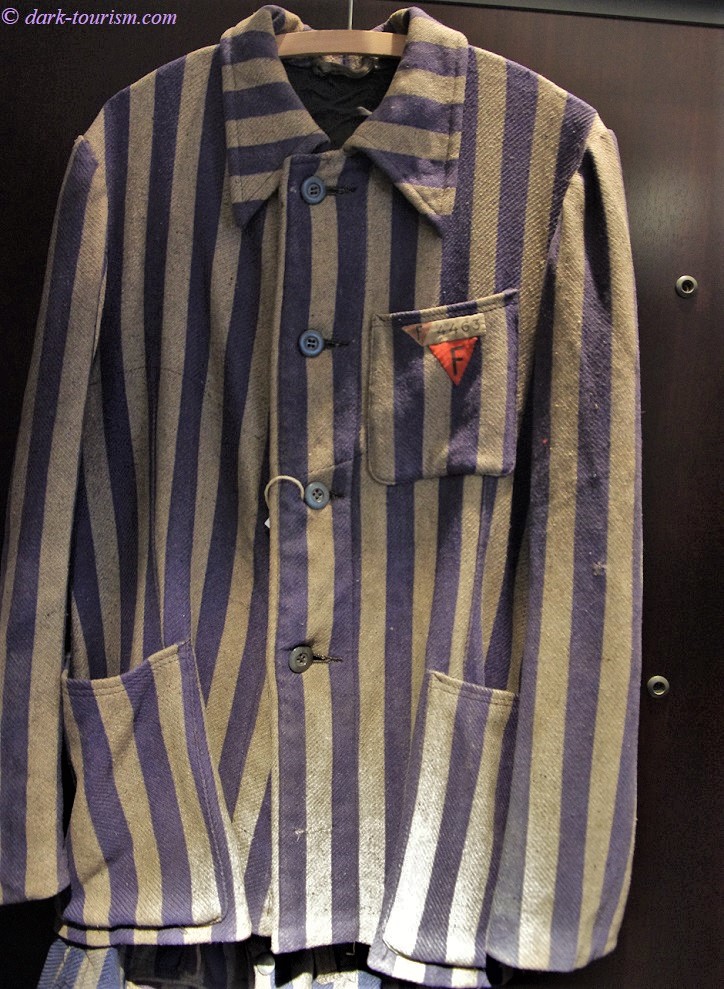
Of course, putting prisoners in striped clothing is anything but unique to the Nazi concentration camps and has been quite common elsewhere. Just one example; this is a prisoner dummy on display at the former penal colony prison of Ushuaia in southern Argentina:
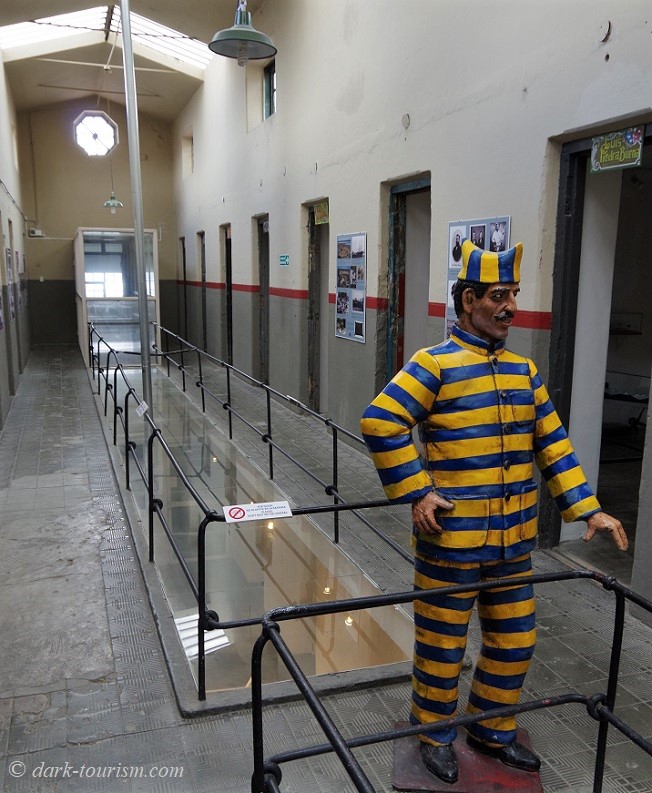
In more modern times, however, prisoner clothing has often been much blander, such as these late-GDR-era inmate outfits on display at the memorial at the former Stasi remand prison Hohenschönhausen in Berlin, Germany:
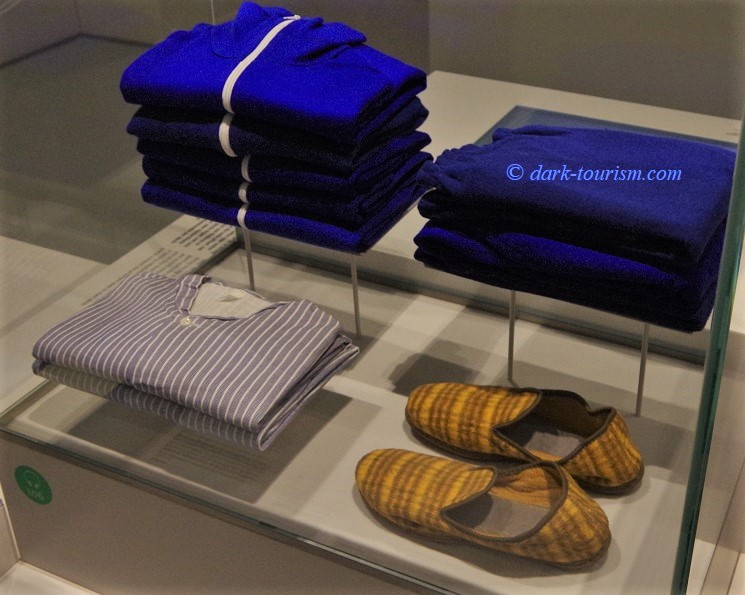
Speaking of the Eastern Bloc and communist regimes – the darkest aspect of all that was surely the Gulag system of the Soviet Union. The Gulags were often located in the far east of Siberia or northern Russia, and inmates had to do forced labour under atrocious conditions in the freezing cold, wearing padded jackets and felt boots, such as these on display at the Perm-36 Gulag memorial in Russia:
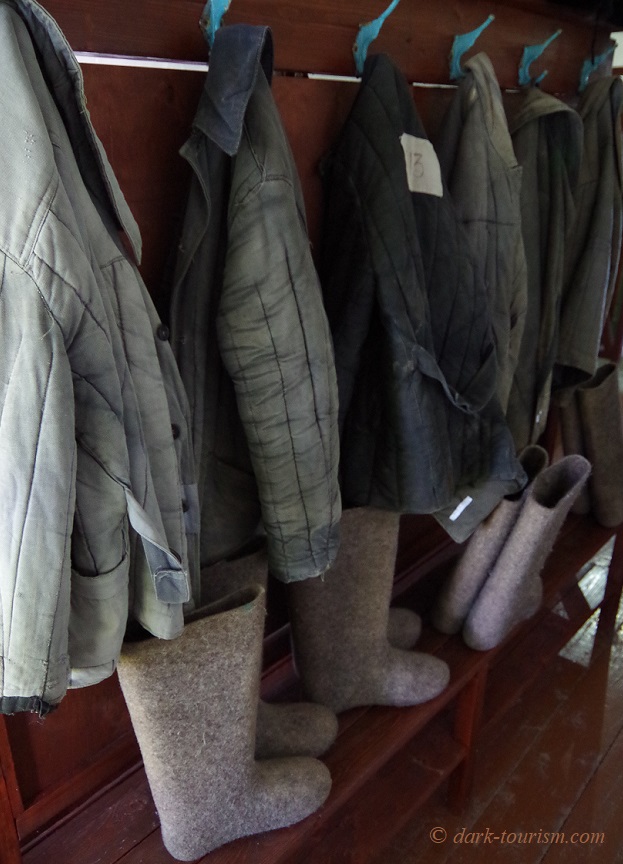
The other category of clothing with a dark association that may well be expected here is uniforms, especially military uniforms. In fact military-themed museums around the world display endless uniforms, so I have to be very selective here. This one, on display at the War Museum in Kaunas, Lithuania, I found especially striking:
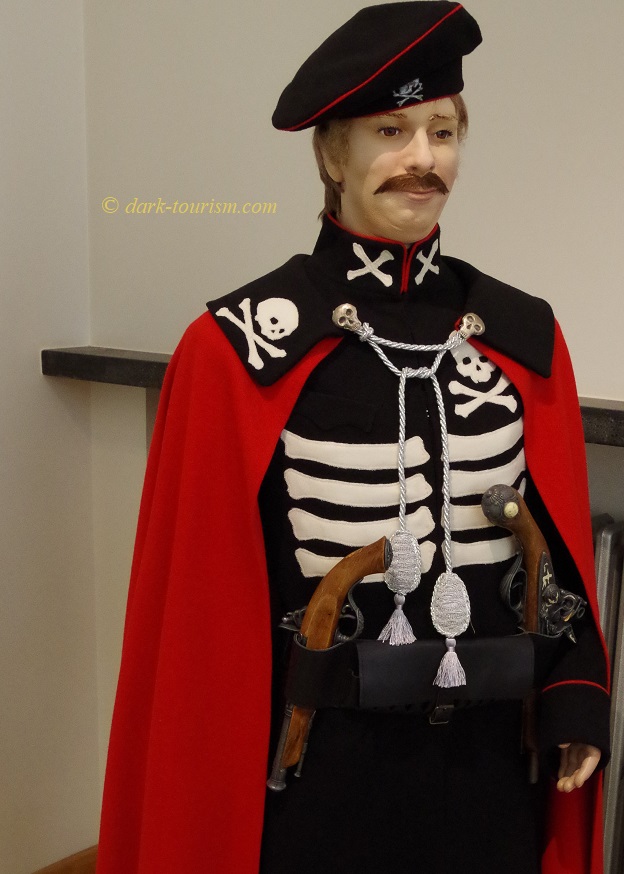
Quite possibly the most infamous type of uniform were the SS-clothes, worn by the perpetrators of the worst crime against humanity, the Holocaust. Here’s just a cap, of the SS-Totenkopfverbände (literally ‘death head units’, though “Totenkopf” actually means ‘skull’), the kind of photo that could get you banned from Facebook, but here we are fortunately out of the reach of the FB Gestapo. The photo was taken in the Military Museum in Belgrade, Serbia:
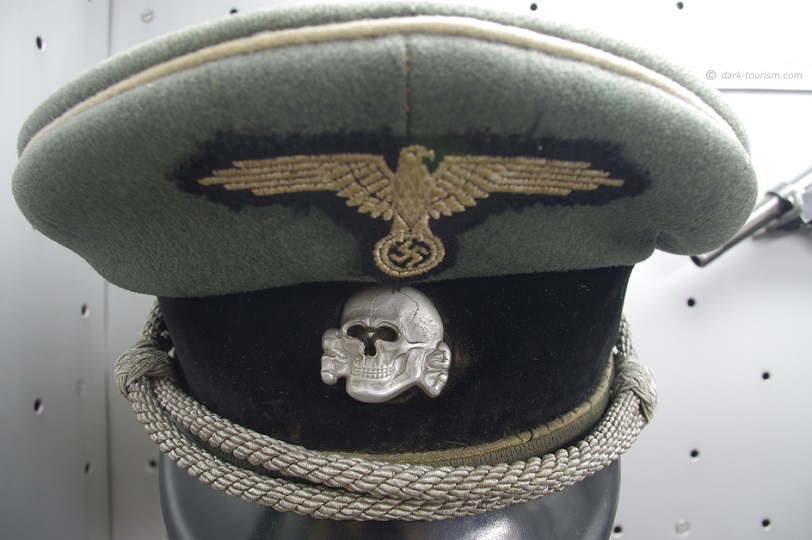
Military clothes to be worn in actual combat, i.e. battledress or ‘military fatigues’, are these days designed primarily with practicalities in mind, hence they are often olive green or sand coloured (for desert warfare) or have camouflage patterns, such as this piece, a German ISAF outfit on display at the excellent Military History Museum in Dresden, Germany … the (last) name on it happens to be the same as my first name, so I found this slightly disturbing to see:
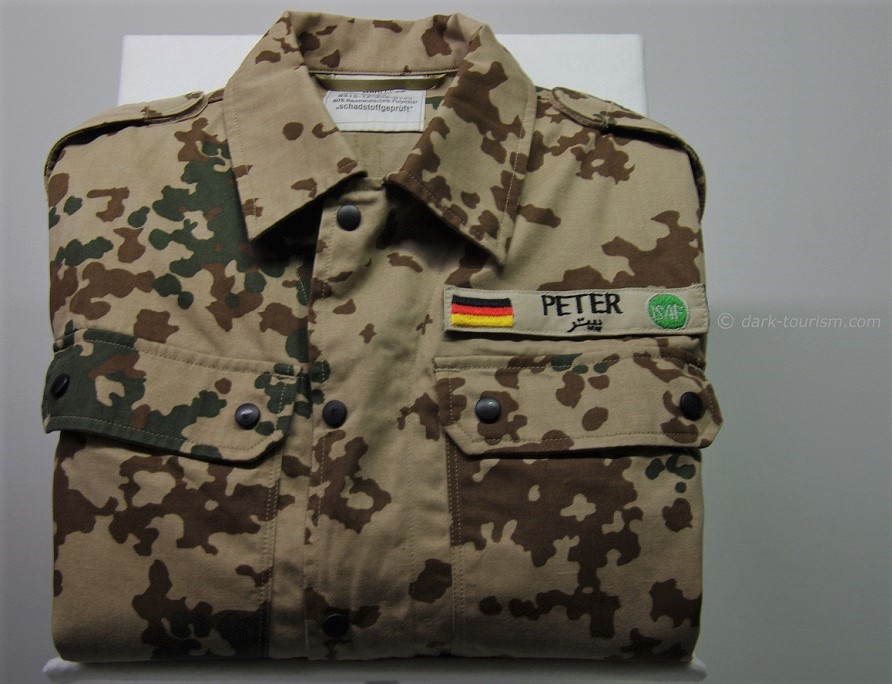
ISAF, by the way, stands for ‘International Security Assistance Force’, the NATO-led military mission in Afghanistan established in December 2001.
Military uniforms not intended for combat are often for ceremonial purposes; and the most flamboyant examples I’ve ever seen were the outfits of the soldiers involved in the daily border-closing ceremony at Wagah, on the border between India and Pakistan. Check this outrageous outfit, worn by one of the soldiers on the Indian side:
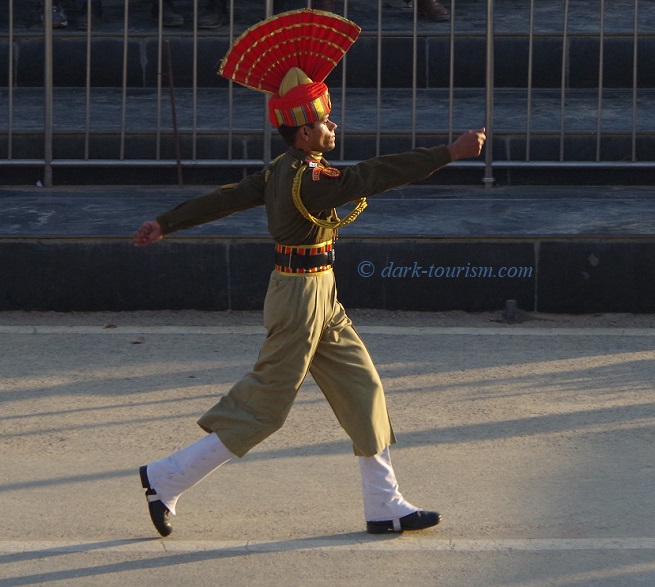
The outfits of the equivalent border-ceremony soldiers on the Pakistani side are only marginally more restrained. Note also the ritual posture with raised fists being waved at the “enemy” (the whole ceremony is really just a highly ritualized representation of the two countries’ arch-enmity):
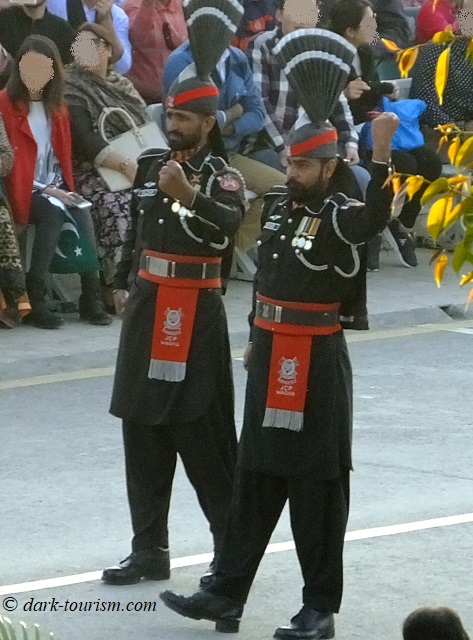
Sometimes ceremonial uniforms are on public display because they were worn by famous people, like heads of state, such as this iconic white uniform studded with medals that was worn by Tito, founder and leader of the former Yugoslavia until his death in 1980. It’s now in a glass cabinet at the Tito mausoleum & museum in Belgrade:
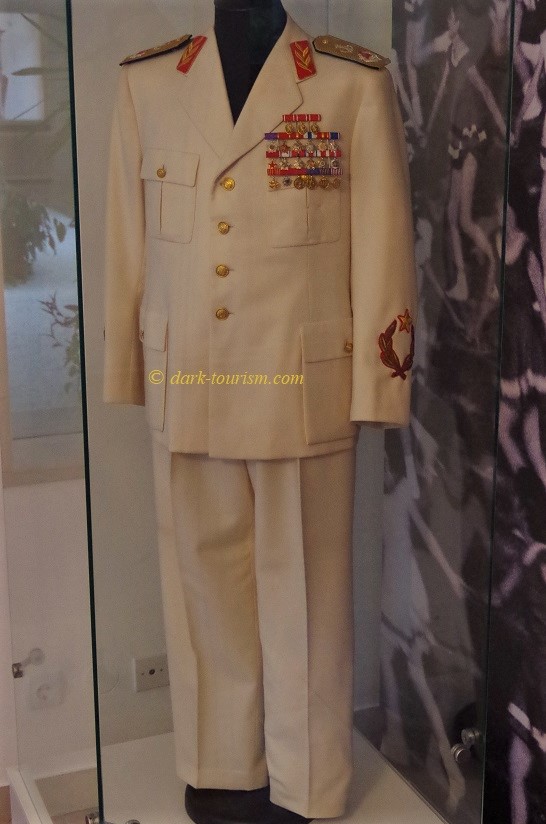
Perhaps the darkest ceremonial uniform that is on display in a museum is this one, which was worn by Archduke Franz Ferdinand when he was assassinated in Sarajevo, Bosnia, which triggered the First World War:
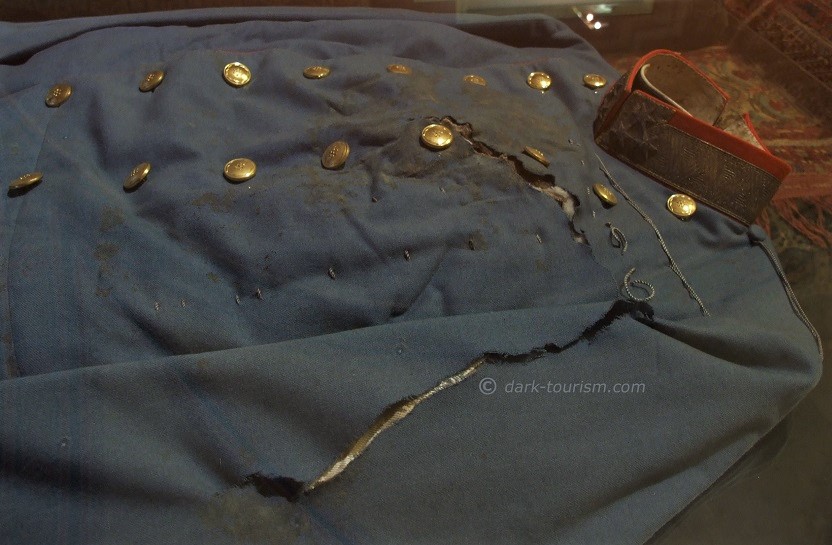
This bloodied uniform is on display in the Military History Museum (Heeresgeschichtliches Museum, HGM) in Vienna, Austria. The hole that the bullet tore through the neck collar used to be gleefully pointed out by an arrow, but that’s been removed in the revamp of the WW1-section for the 2014 centenary of the outbreak of the Great War.
Not part of a uniform, but also featuring a bullet hole is this jacket, worn by Michael McDaid, who was shot dead by British soldiers during Bloody Sunday in 1972 in Derry/Londonderry, Northern Ireland, and is now on display in the Museum of Free Derry in that city, in this case still with a little arrow marking the bullet hole:
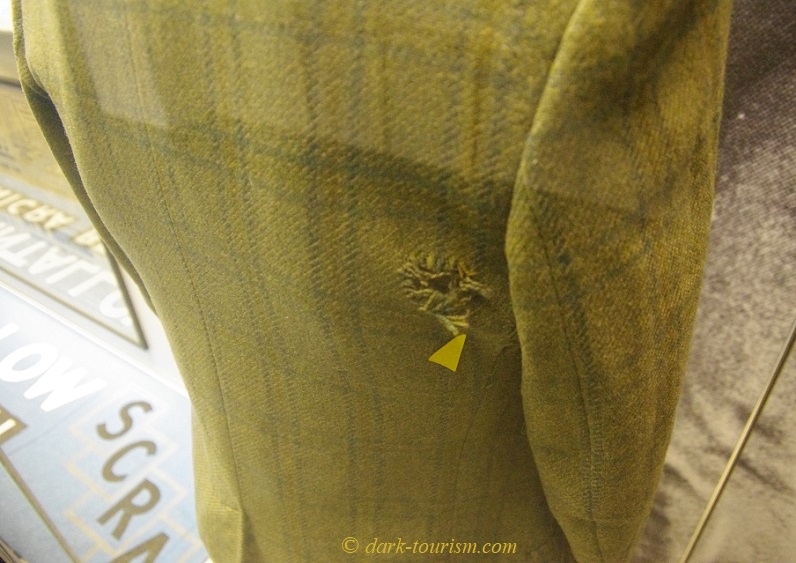
As far as bloodstained clothes are concerned, though, nothing is more shocking than the displays of heaps of blood-drenched clothing worn by hundreds if not thousands of victims of the 1994 Rwandan genocide that are strewn all over the pews of the former church of Nyamata, one of the most hard-hitting genocide memorials in Rwanda:
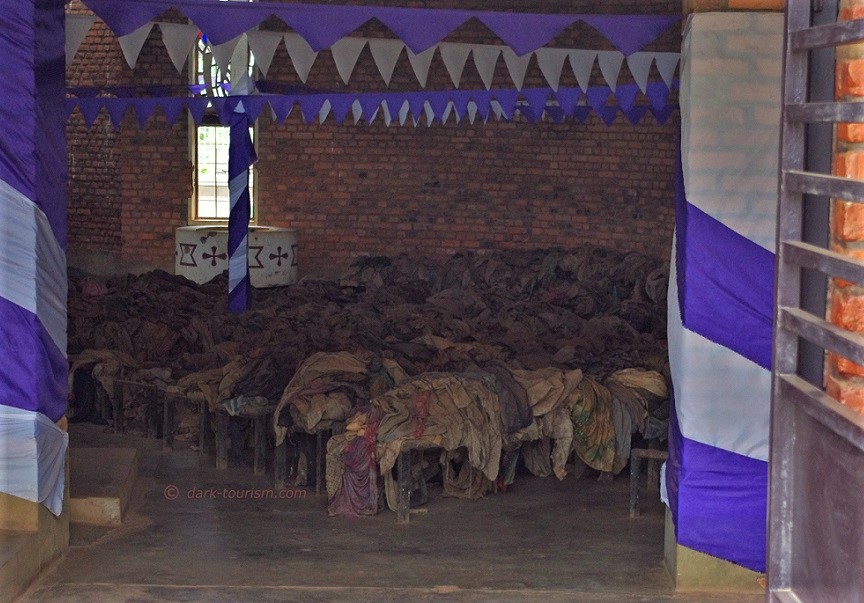
Also not strictly speaking a uniform, but so common that it was almost like one, were the woolly jumpers worn by the members of the Norwegian resistance during the occupation of the country by the Third Reich. Every history and/or war-related museum in Norway has at least one such display (this one is at the Resistance Museum in Bergen):
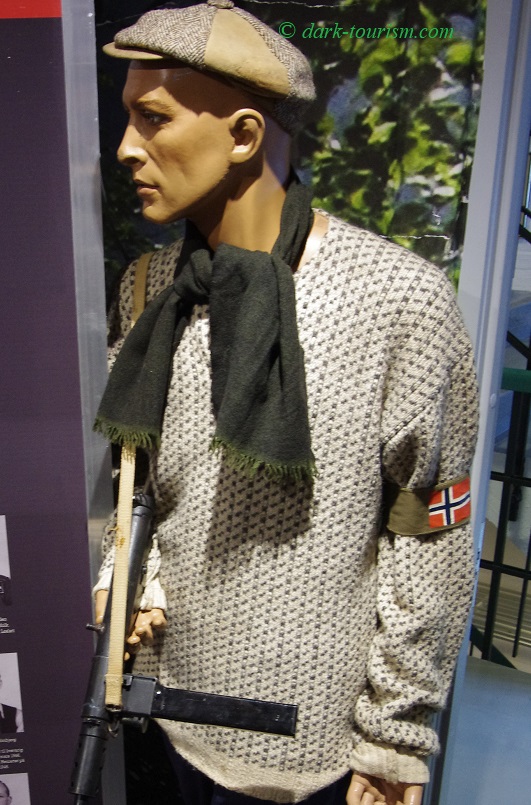
Modern warfare brought with it nuclear, biological and chemical (NBC) weapons of mass destruction, and so also a third category of military clothing (in addition to battle fatigues and ceremonial uniforms), namely protective ‘NBC suits’ complete with gas masks, such as these on display at a former Cold-War-era bunker in Prague, Czech Republic:
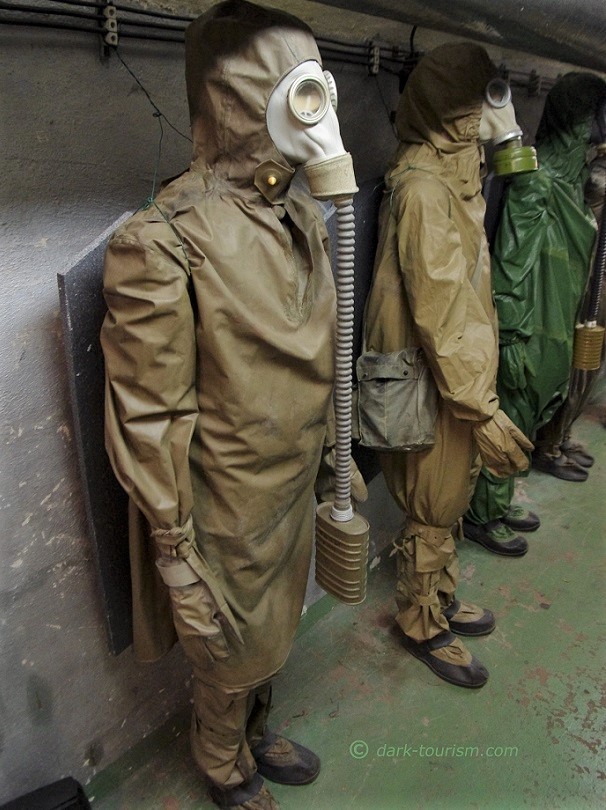
The ultimate type of protective clothing, however, has to be the spacesuit, without which anybody in outer space would instantly die. If that’s not dark enough, consider this particular spacesuit:
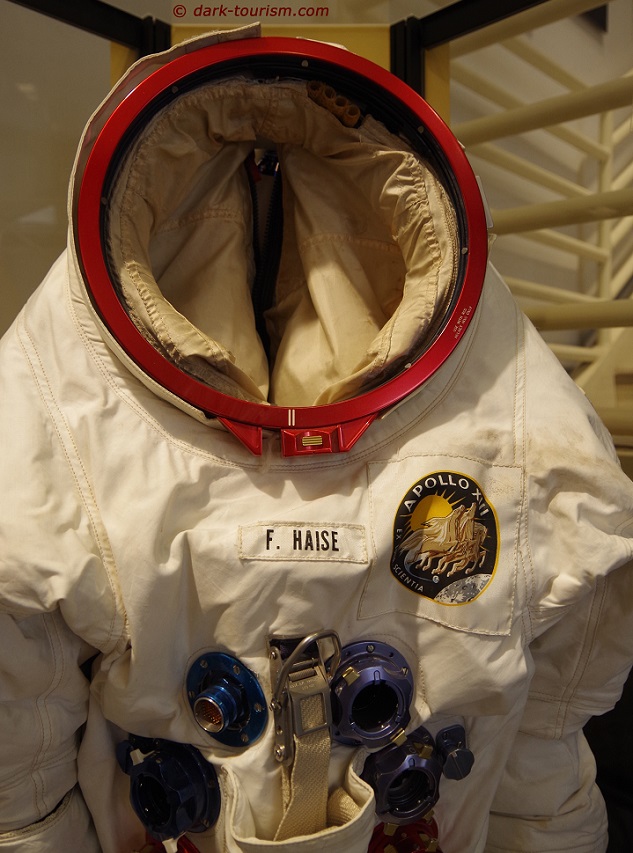
This suit was worn by F. Haise, a member of the ill-fated Apollo 13 mission, which almost ended in the USA’s worst disaster in space. An oxygen tank of the service module exploded en route to the moon and the three-man crew had to move into the lunar landing module, which was designed for only two occupants, and survive on limited oxygen at freezing temperatures while they circled the moon and headed back to Earth. They did survive and managed to reactivate the main capsule to perform the landing manoeuvre to return safely to Earth – but it was a very close shave. Haise’s Apollo 13 spacesuit is on display at the Onizuka Space Center museum on Hawaii, which is named after a Hawaiian-born astronaut who perished in the 1986 Challenger space shuttle disaster.
I’ve never worn an NBC suit or spacesuit, but occasionally you do need some level of protective clothing as a dark tourist, e.g. face masks and overshoes at the former nuclear testing ground of Semipalatinsk in Kazakhstan, or the proper respirator with filters and the gloves I had to wear when I climbed into the crater of Ijen in Indonesia. The clouds of sulphurous gas that the volcano emits are so acrid that you couldn’t breathe properly down there. It was still burning the eyes though, so when a cloud of sulphur gas wafted straight over me I had to hold still and close my eyes until it had blown over. This is a photo my wife took of me when we were down there at night (to see the fabled blue flames of Ijen, which you can only see when it’s dark):
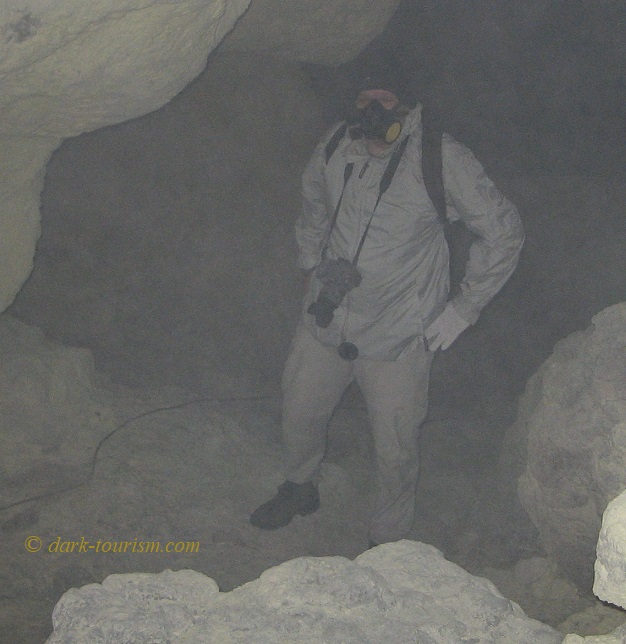
Sometimes a dark association of clothing is with a natural or man-made disaster; and in this case it’s both at the same time, as it were:
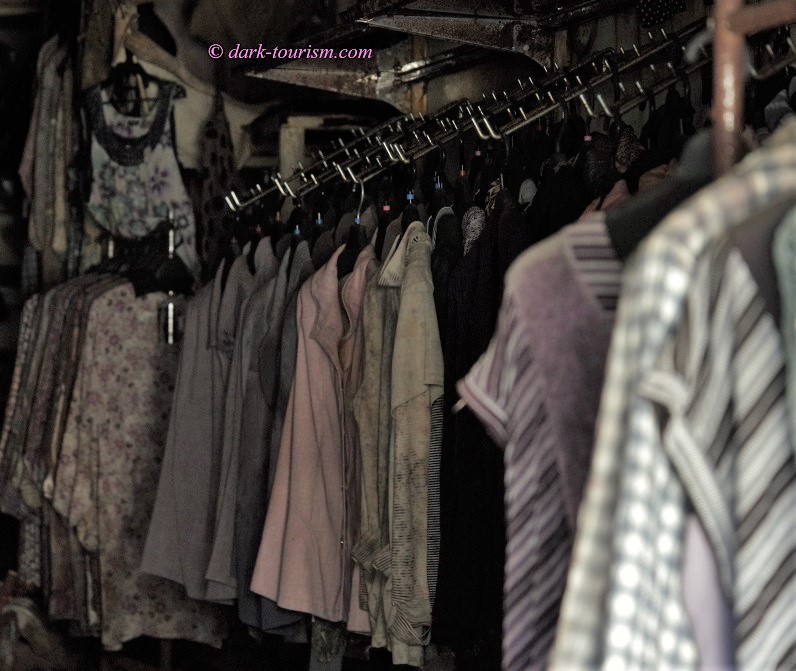
This photo was taken in the abandoned ghost town of Okuma, which is in the exclusion zone that was declared after the triple disaster on 11 March 2011 in Japan, when an earthquake triggered a massive tsunami which also overwhelmed the nuclear power station of Fukushima-Daiichi. As a consequence of emergency power loss, the plant suffered explosions and core meltdowns in three of its reactor blocks. The released radioactive contamination necessitated the evacuation of tens of thousands of residents in the towns and villages around the disaster site. Those in the innermost “Red Zone” are still ghost towns and normally access is strictly forbidden. But on our Japan trip in the spring of last year we went on a Fukushima tour with a licensed guide who obtained official permits which allowed brief access to some parts of the exclusion zone, including a street in Okuma, where I spotted this abandoned clothes shop. Its wares were still hanging neatly on their pegs and hangers, only the slightly faded colours were an indication that they had been there untouched for over eight years.
And apropos nuclear power, the following photo was taken at “the safest nuclear power station in the world”, namely at Zwentendorf in Austria. It’s so safe because it was never used, since a referendum resulted in the population’s rejection of nuclear power in 1978. So the Zwentendorf plant, where construction had begun in 1972 and was just completed in 1978, was never fitted with fuel rods and has hence never seen any radiation. Today it’s a training centre, occasional film set, source of spare parts for other plants of the same type in Germany, and you can go on guided tours offered to the public … though it’s incredibly hard to get a place on these tours – they usually fill up as soon as they are announced. I was lucky to get on one of the special tours offered throughout the day when it was the 35th anniversary of the referendum. This photo was taken on that tour and shows plant workers’ clothing in the staff changing room. Note the yellow underwear – that would have been convenient had there been a serious nuclear accident causing the staff to pee their pants 😉
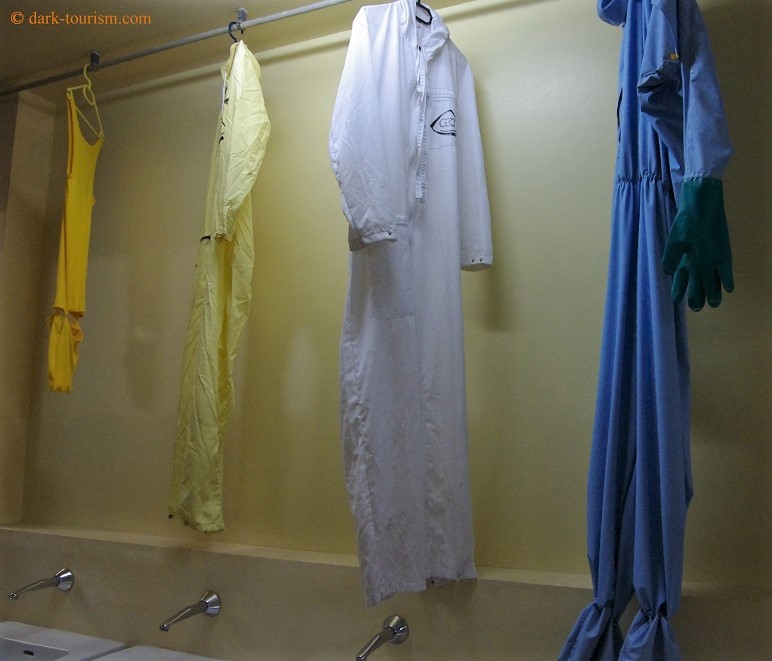
Sometimes the dark association with items of clothing is that they were worn by a famous dead person, as in this case (same as the lead photo at the top of this post):
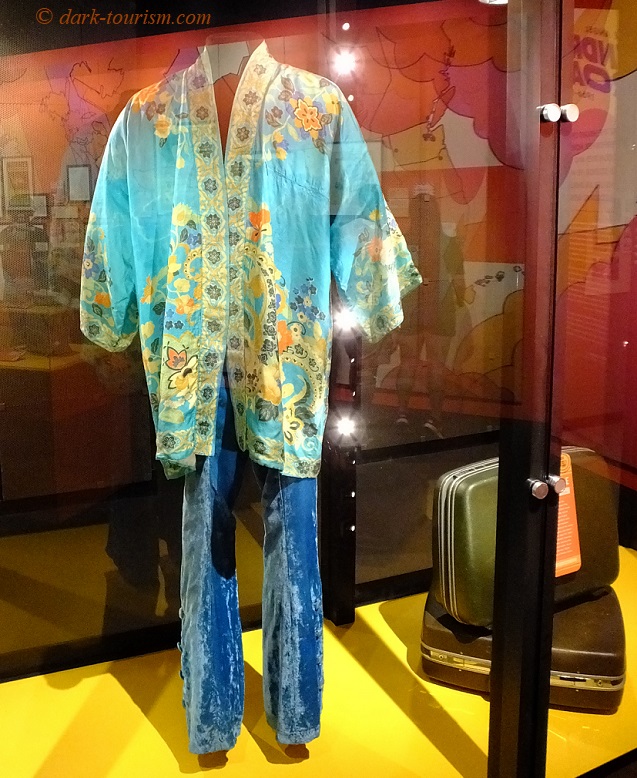
These clothes were worn by the legendary electric guitar virtuoso Jimi Hendrix, who died in 1970 from an overdose aged only 27. They are now on display at the EMP in Hendrix’s birth city of Seattle. They also demonstrate well how fashions change. These days a shirt such as the one in this photo would only be worn by nostalgic ex-hippies, or perhaps retro-minded neo-hippies.
The vagaries of fashion sometimes even include a darkish political element, such as in these GDR-era women’s outfits on display at the “Life in the GDR Museum” in Berlin:
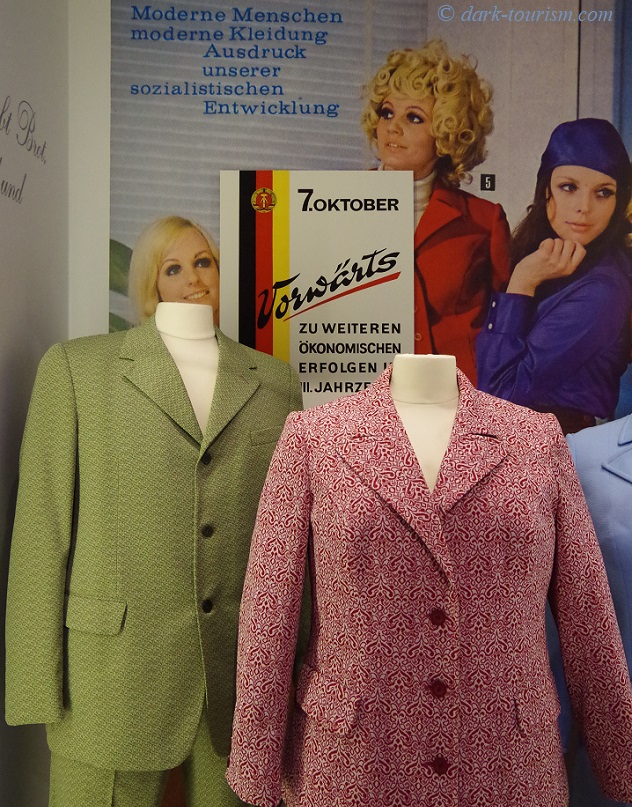
The inscription in blue behind these outfits and next to the photo of that poodle-hairdo woman claims as euphorically as euphemistically: “modern people / modern clothing / expression of our socialist development”. In reality, of course, many East Germans back in those days would much rather have worn blue jeans or other Western clothing, even shirts like Jimi Hendrix’s, instead of these incredibly dull-coloured suits.
Sometimes clothes can have a more indirect association with something dark like a disaster, as in this case a shipwreck, and not just any but quite probably the most legendary shipwreck of all time:
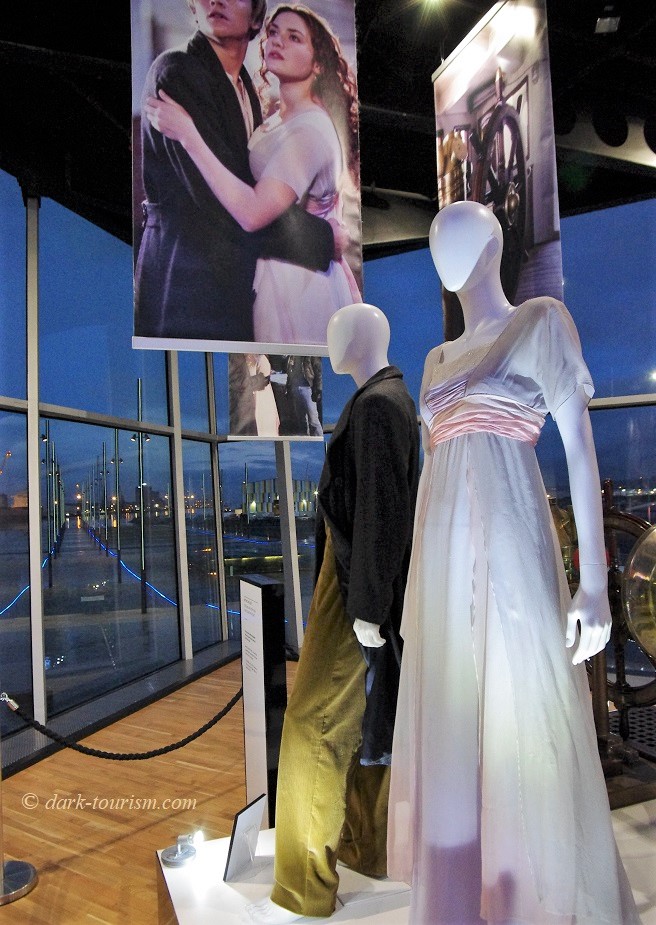
These outfits were used in the 1997 movie “Titanic” directed by James Cameron, more specifically the dress in the foreground was worn by actress Kate Winslet, and the male outfit by Leonardo DiCaprio, who played the lead roles in the film. The clothes are on display at the “Titanic Belfast” attraction in Northern Ireland’s capital – an institution that prefers being referenced as an “experience” rather than a “museum”. For many decades the sinking of the Titanic, which had been built in Belfast, was rather embarrassedly hushed up in Belfast, but that changed when the centenary of the disaster came. Now the story of the Titanic is a pivotal part of the tourism industry in that city, and the “Titanic Belfast” is now its No. 1 visitor attraction. Things change, not only in fashion …
Another Titanic-related display involving a dress can be found at the Cité de la Mer maritime museum in Cherbourg, Normandy, France. The light installation around this life-size mock-up of a first-class cabin on the Titanic is supposed to recreate the ship going under water:
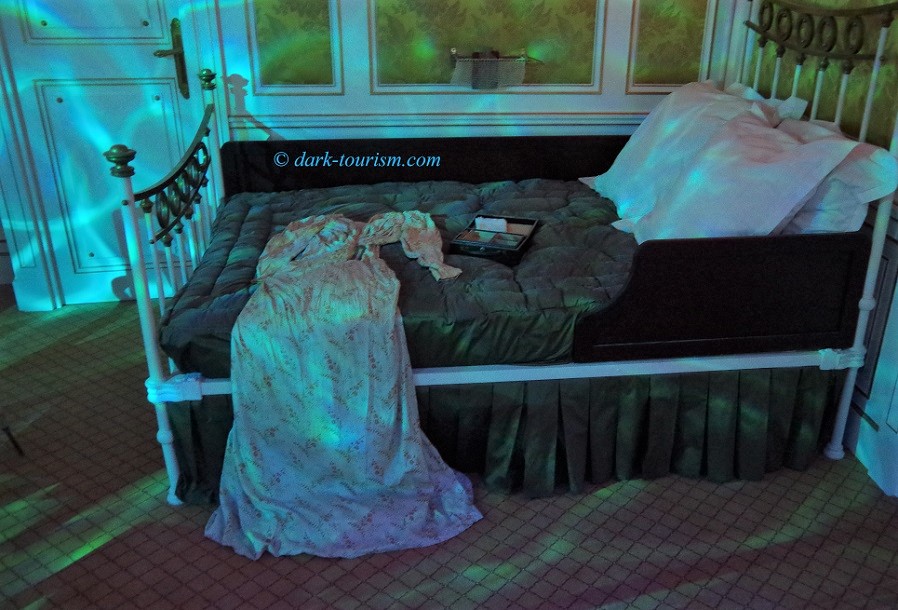
The last but one photo of this post also features clothing worn by actors in movies, in this case James-Bond films, namely by actors Richard Kiel and Hervé Villechaize who played evil sidekicks of the main villains in the films. These were the role of the giant “Jaws” (Kiel) in “The Spy Who Loved Me” and “Moonraker” and the role of midget “Nick Nack” (Villechaize) in “The Man with the Golden Gun”. The clothes and shoes are now on display in the German Spy Museum in Berlin, which not only covers real-life espionage but also famous depictions thereof in popular culture, hence the inclusion of Bond movies.
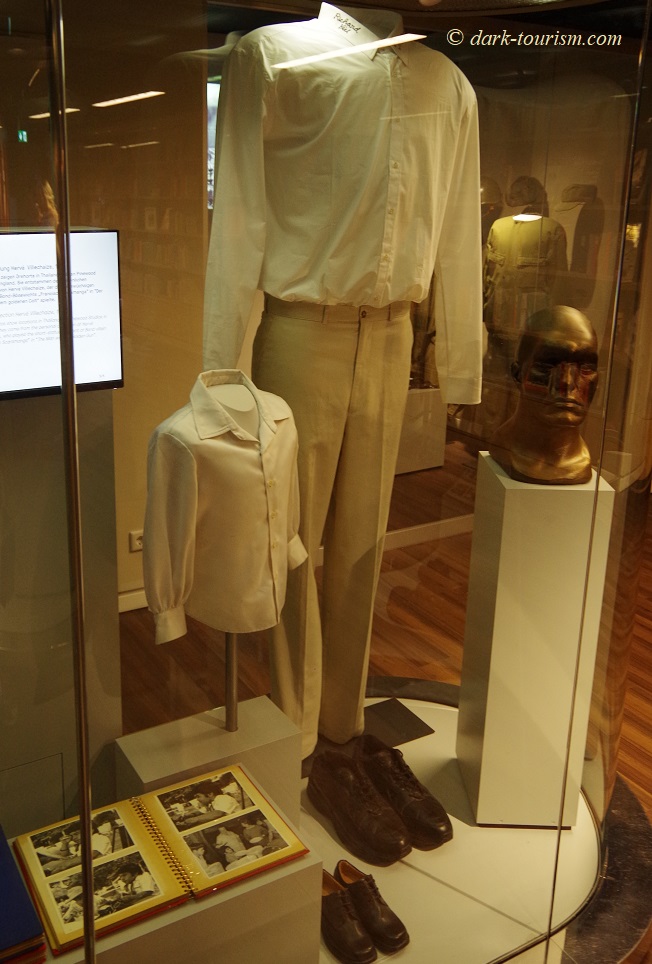
And finally I bring you something that is not in itself so dark, but just bizarre – a dress made entirely from condoms:
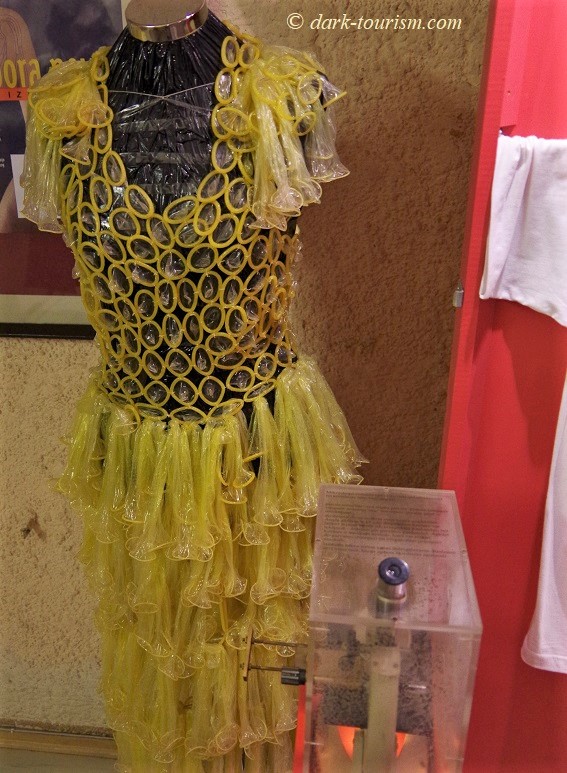
This I spotted in the Paul Stradins Museum of the History of Medicine in Riga, Latvia, where it was one of the most unusual artefacts in the exhibition, which is excellent, by the way, and includes plenty of rather dark aspects …
As I said before, I could have featured lots more photos of clothing that have in some way a link to dark tourism, but sometimes good enough has to be good enough. This post already features 25 images, far more than any other post on this blog so far. So I’ll leave it at this.




5 responses
Also, let’s not forget the nudist beaches of Crimea. No clothing, but plenty of dark tourism.
PS: Very good post. One of the most interesting.
haha, no clothes as part of the theme DT & clothes? Well, why not. And yes, Crimea would be a cool dark destination; I know people who’ve been (Balaklava would be my No. 1 attraction), but I haven’t managed it yet. Also now it’s a bit more complicated and requires a Russian visa … if you could go at all, I mean. At the moment travel is more or less dead. PS: Thanks for praising the post. I’m quite pleased with it too, if I can say so myself 😉
Excellent blog – the different angles on these themed blogs gives an additional perspective on dark tourism!
I’m just reading ‘Gulag’ by Anne Applebaum (following on from reading ‘The Lost Pianos of Siberia’ by Sophy Roberts) so was especially interested by those gulag uniforms.
thanks; yes I also enjoy writing these themed posts … I still have a whole host of further ones I could do.
We have that Appelbaum book too. but I haven’t got round to reading it yet. Must do one day … And you could take a look at my chapter about the only proper gulag memorial in Russia, Perm-36!
It’s interesting to see movie costumes from “Titanic” displayed in Belfast’s “Titanic Belfast” attraction and a Titanic-themed exhibit in Cherbourg, France.
These artifacts connect us to the legendary shipwreck’s history and how it has evolved into a central part of tourism in Belfast.
Clothing, even from a movie, can offer a tangible link to historical events, making history more immersive and relatable.